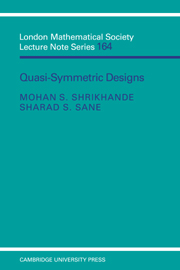Book contents
- Frontmatter
- Contents
- Preface
- Acknowledgments
- I Basic results from designs
- II Strongly regular graphs and partial geometries
- III Basic results on quasi-symmetric designs
- IV Some configurations related to strongly regular graphs and quasi-symmetric designs
- V Strongly regular graphs with strongly regular decompositions
- VI The Witt designs
- VII Extensions of symmetric designs
- VIII Quasi-symmetric 2-designs
- IX Towards a classification of quasi-symmetric 3-designs
- X Codes and quasi-symmetric designs
- References
- Index
Preface
Published online by Cambridge University Press: 05 May 2010
- Frontmatter
- Contents
- Preface
- Acknowledgments
- I Basic results from designs
- II Strongly regular graphs and partial geometries
- III Basic results on quasi-symmetric designs
- IV Some configurations related to strongly regular graphs and quasi-symmetric designs
- V Strongly regular graphs with strongly regular decompositions
- VI The Witt designs
- VII Extensions of symmetric designs
- VIII Quasi-symmetric 2-designs
- IX Towards a classification of quasi-symmetric 3-designs
- X Codes and quasi-symmetric designs
- References
- Index
Summary
Combinatorics is generally concerned with counting arrangements within a finite set. One of the basic problems is to determine the number of possible configurations of a given kind. Even when the rules specifying the configuration are relatively simple, the questions of existence and enumeration often present great difficulties. Besides counting, combinatorics is also concerned with questions involving symmetries, regularity properties, and morphisms of these arrangements. The theory of block designs is an important area where these facts are very apparent. The study of block designs combines number theory, abstract algebra, geometry, and many other mathematical tools including intuition. In the words of G.C. Rota (in: Studies in Combinatorics, Mathematical Association of America, 1978),
“Block designs are generally acknowledged to be the most complex mathematical structures that can be defined from scratch in a few lines. Progress in understanding and classification has been slow and proceeded by leaps and bounds, one ray of sunlight followed by years of darkness. …This field has been enriched and made even more mysterious, a battleground of number theory, projective geometry and plain cleverness. This is probably the most difficult combinatorics going on today…”
In the last few years, some new text-books (Beth, Jungnickel and Lenz, Hughes and Piper, Wallis) on Design Theory have been published. Dembowski's ‘Finite Geometries’, M. Hall Jr.'s ‘Combinatorial Theory,’ and Ryser's ‘Combinatorial Mathematics’ are regarded as some of the classic references in combinatorics, particularly in the area of designs.
- Type
- Chapter
- Information
- Quasi-symmetric Designs , pp. ix - xvPublisher: Cambridge University PressPrint publication year: 1991



